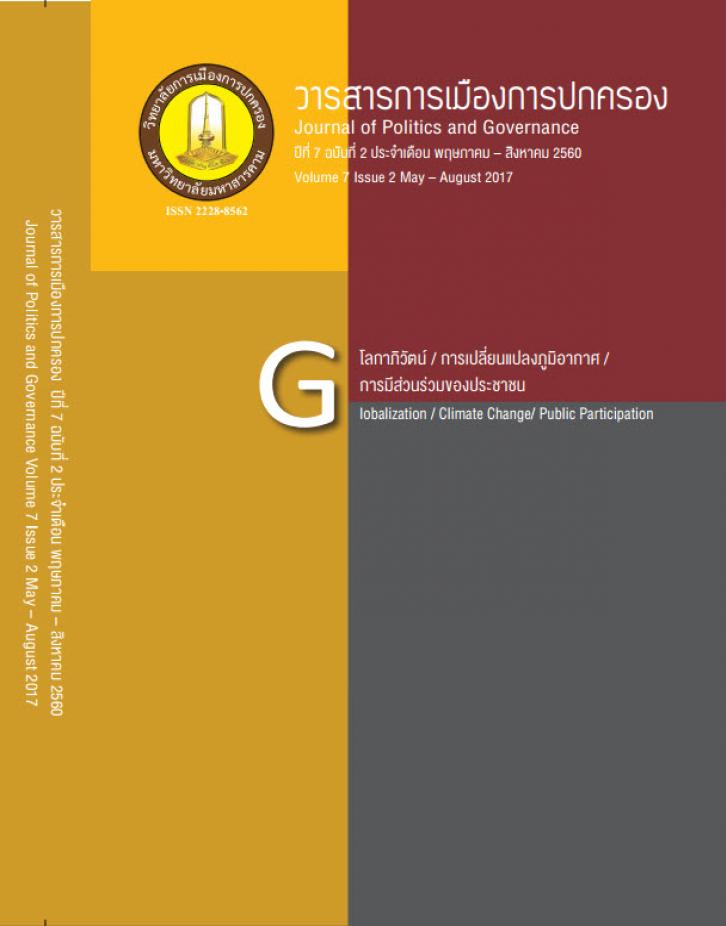Community Involvement in Monitoring Carbon Stock: the Possibility for REDD+ Implementation in Thailand
Main Article Content
Abstract
This research aims to propose possible reform directions for involving community in monitoring carbon stock in REDD+ implementation in Thailand. Engaging community in monitoring carbon stock in forest could help ensure more effective REDD+ implementation both in terms of carbon sequestration and improving the livelihoods of, particularly, forestry communities in REDD+ implementation. This research employed doctrinal methods and documentary analysis, which mainly involved reviewing literature from a wide range of secondary sources including articles, research reports, books, website, and government documents.
The literature review emphasised that legal framework of Thailand fails to enable effective community involvement in monitoring carbon stock for REDD+ implementation. This research, therefore, makes some suggestions to enable effective community involvement in monitoring carbon stock for REDD+ implementation in Thailand.
Article Details
References
Asia Indeginous Peoples CCMIN, REDD+ implementation in Asia and the concerns of Indigenous Peoples Asia Indeginous Peoples CCMIN
Berkes, F., Colding, J. &Folke, C. (2000). Rediscovery of traditional ecological knowledge as adaptive management. Ecological Applications, 10, pp.1251–1262. Available at:http://www.jstor.org/stable/2641280.
Bradley et al. (2013). Gender and REDD+: An Assessment in the Oddar Meanchey Community Forestry REDD+ Site, Cambodia, < http://www.wocan.org/resources/gender-and-redd-assessment-oddar-meanchey-community-forestry-redd-site-cambodia>
Brofeldt, Søren et al. (2014). Community Monitoring of Carbon Stocks for REDD+: Does Accuracy and Cost Change over Time?. 5 Forests.
Copenhagen Centre for development research department of food and resource economics University of Copenhagen, 'Communities can monitor forest carbon ‘as well as experts’ ‘ (Policy Briefs No.2, Copenhagen Centre for Development Research Department of Food and Resource Economics University of Copenhagen 2014)
Danielsen, F., Burgess N.D., Balmford, A. (2005). Monitoring matters: examining the potential of locally-based approaches. BiodivConserv. 14, 2507–2542.< www.monitoringmatters.org.>
Doswald, N., Zimmermann, F. & Breitenmoser, U., (2007) .Testing expert groups for a habitat suitability model for the lynx Lynxlynx in the Swiss Alps.Wildlife Biology,13(4), pp.430‐446. < http://dx.doi.org/10.2981/0909‐6396(2007)13[430:TEGFAH]2.0.CO.>
Finn Danielsen et al. (2013). Community Monitoring for REDD+: International Promises and Field Realities’. Ecology and Society, 18 (3)
Forest Carbon Partnership Facility (FCPF). (2011). Linking community monitoring to national Measurement, Reporting and Verification for REDD+. Prepared by the Centro de Investigaciones en GeografíaAmbiental, Universidad Nacional Autonoma de México (CIGA‐UNAM).
Global Canopy Program. (2012). How community forest monitoring can enable countries to achieve national and international REDD+ objectives. Policy Working Paper, (GCP).
Jannie Lasimbang and Chingya Luithui. (2006). 'Natural Resource Management Country Studies: Thailand' (United Nations Development Programme: Regional Indigenous Peoples’ Programme, United Nations)
Korhonen-Kurki, Kaisa et al. (2012). Multiple levels and multiple challenges for REDD+' in Arild Angelsen et al (eds), Analysing REDD+: Challenges and choices (Center for International Forestry Research (CIFOR),) 91
Larson, Anne M. (2011). Forest tenure reform in the age of climate change: Lessons for REDD+. Global Environmental Change, 540,21(2)
Martin, Paul and Miriam Verbeek. (2006). Sustainability Strategy. (The Federation Press,)
Minichiello, Victor, Rosalie Aroni and Terrence Hays. (2008). In-depth interviewing : principles, techniques, analysis. (Pearson Education Australia)
Pratihast, A &Herold, M. (2011). Community Based Monitoring and potential links with National REDD+ MRV. Input paper no. 1 for the FCPF workshop. Wageningen University, the Netherlands
REDD+Partnership, REDD+Partnership Document 2010 REDD+Partnership
Regional Office for Asia and the Pacific of Food and Agriculture Organisation of the United Nations, 'Thailand Forestry Outlook Study' (Asia- Pacific Forestry Sector Outlook Study II- Working Paper Series No. APFSOS II/WP/2009/22, Food and Agriculture Organisation of the United Nations, 2009)
S. Fordham et al. (2012). Community Forest Monitoring and REDD+: How community forest monitoring can enable countries to achieve national and international REDD+ objectives. Policy Working Paper, Global Canopy Programme (GCP), 5.
Sunderlin, William D. and Stibniati Atmadja. (2009). Is REDD+ an idea whose time has come, or gone?' in Arild Angelsen et al (eds), Realising REDD+: National strategy and policy options (Center for International Forestry Research (CIFOR)) 45.
Sustainable Mekong Research Network. (2013). Research on integrating community-based participatory carbon measurement and monitoring with satellite remote sensing and GIS in a measurement, reporting and verification (MRV) system for REDD+' (Sustainable Mekong Research Network).
UN-REDD Programme Vietnam. (2011). Piloting Participatory Carbon Monitoring in Vietnam retrieved from < http://vietnam-redd.org/Programs>.
Wertz-Kanounnikoff, Sheila and Arild Angelsen. (2009). Global and national REDD+ architecture Linking institutions and actions' in Arild Angelsen et al (eds), Realising REDD+: National strategy and policy options (Center for International Forestry Research (CIFOR)) 13.


